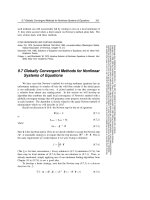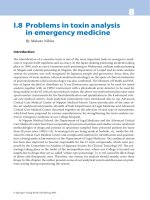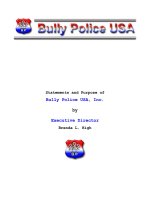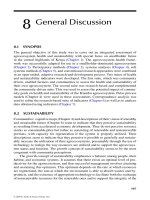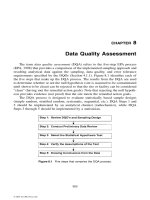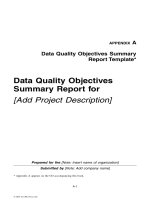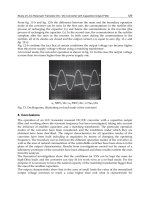Soil Sampling and Methods of Analysis - Part 8 (end) pdf
Bạn đang xem bản rút gọn của tài liệu. Xem và tải ngay bản đầy đủ của tài liệu tại đây (80.5 KB, 12 trang )
Appendix A
Site Description
G.T. Patterson
Agriculture and Agri-Food Canada
Truro, Nova Scotia, Canada
J.A. Brierley
Agriculture and Agri-Food Canada
Edmonton, Alberta, Canada
A1 INTRODUCTION
A site description is a record of observations for a specific locale, where soil and landscape
attributes are to be evaluated. A site can be of any size ranging from under a square meter to
several square kilometers or more in extent.
The amount of data recorded at a site as well as the required precision is dependent upon the
purpose of the project. The purpose also determines the selection of an appropriate site. For
example, demonstration plots must be easily accessible and preferably visible from the road
(Maguire and Jensen 1997). Although there are exceptions, sites are generally chosen to be
representative of a typical soil–climate–landscape situation.
Information about the site serves as the link between the actual location, associated
landscape and soil characteristics, and corresponding relevance of the samples. A site
description provides the context for the various soil properties to be analyzed and may
help in the final evaluation and interpretation of analytical results (North Dakota State
University [N DSU] Extension Service 1998; Schoeneberger et al. 2002). A good site
description also defines how information gained at one location can be extrapolated to
other areas.
Site information can be classified into three categories: basic sampling data, such as (a) who
did the sampling, where, when, and why; (b) information about the landscape; and (c) a
summary of the soil horizon data (Soil Survey Staff 1951; Taylo r and Pohlen 1962;
Walmsley et al. 1980; Day 1983; Kna pik et al. 1988; USDA 2002). As men tioned previ-
ously, the specific site attributes collected depend upon the nature of the project, and thus
ß 2006 by Taylor & Francis Group, LLC.
there can be no definitive list. However, as a minimum, the first two categories should be
always include d. If the results of a study are to be scal ed-up to broader areas or interpreted
within a regional context, then soil horizon data are necessary in order to apply soil
classification systems (Soil Survey Staff 1975; Webster and Butler 1976; Soil Classification
Working Group 1998).
Various methods are available for measuring site attributes. Consider location, for example.
Latitude–longitude measurements of location based upon National Topographic Survey
maps may be appropriate at the national level, while legal descriptions might be more
appropriate at the farm level. Where more precise location coordinates are required,
geographic positioning systems (GPS) are readily available devices for accurately locating
a site (latitude, longitude, and elevation) to within submeter confidence. The list of GPS Web
sites at the end of this chapter is a sample of what is available; it is not an endorsement of one
product over another.
All site data are not necessarily measured in the field. Soil survey reports, surficial, and
bedrock geology maps, hydrology reports can provide valuable background information on
the landscape and associated soils.
A2 SITE ATTRIBUTES
Tables A1 through A3 provide a list of site attributes applicable to soil-related studies. Table
A1 is a list of basic information related to sample site and sampling method. Landscape and
soil profile attributes are listed in Table A2 and Table A3, respectively.
TABLE A1. A List of Basic Sampling Data
Project ID
Regional setting
1. Purpose, e.g.,
a. Fertility status
b. Environmental assessments (well-site, pipeline)
c. Long-term monitoring
2. Location, e.g.,
a. Latitude–longitude
b. Legal description
c. Latitude–longitude in decimal degrees (GPS)
3. Sampling plan, e.g.,
a. Random
b. Grid
c. Purposeful
d. Single=composite
4. Sampling date
5. Name of sampler
6. Sampling method, e.g.,
a. Probe or auger
b. Core
7. Horizon or depth sampled
8. Vegetative cover (native, crop)
ß 2006 by Taylor & Francis Group, LLC.
TABLE A2. A List of Landscape Attributes
1. Ecological setting
2. Climate
3. Land use
4. Landform
5. Parent material
a. Particle size
b. Mode of deposition including petrology
6. Topography
a. Aspect
b. Elevation
c. Steepness of slope
d. Slope length
e. Shape=curvature
f. Site position
g. Slope pattern
7. Soil moisture regime (e.g., drainage, seepage, perviousness)
8. Stoniness class
9. Rockiness class
10. Flooding events
REFERENCES
Day, J.H. Ed. 1983. The Canada Soil Information
System (CanSIS). Manual for describing soils in
the field. Expert Committee on Soil Survey.
LRRC #82-52. Ottawa, Canada, 97 pp.
GPS Web sites (last verified January 2007).
http:== www.trimble.com=gps
http:== www.garmin.com.=about GPS=
http:== www.omnistar.com
Knapik, L.J., Russell, W.B., Riddell, K.M., and
Stevens, N. 1988. Forest Ecosystem Classifica-
tion and Land System Mapping Pilot Project.
Duck Mountain, Manitoba. Canadian Forest
TABLE A3. A List of Soil Profile Attributes
1. Thickness of layers=horizons
2. Organic layers
a. Thickness
b. Organic material composition
c. von Post scale of decomposition
3. Depth to free carbonates
4. Depth to saline conditions
5. Depth to water table
6. Depth to bedrock
7. Rooting zone
a. Thickness
b. Particle size
8. Root-restricting layer
a. Thickness
b. Kind
c. % Area affected
ß 2006 by Taylor & Francis Group, LLC.
Services and MB Forest Br., Ottawa, Canada
129 pp.
Maguire, T. and Jensen, T. 1997. Guide to Field
Experimentation in Agriculture: Site Location.
Last verified January, 2007. http:== www1.agric.
gov.ab.ca=$department=deptdocs.nsf=all=sag3025
North Dakota State University (NDSU) Extension
Service 1998. Soil sampling as a basis for
fertilizer applicatio n. La st verified January 2 007.
http:== www.ext.nodak.edu=extpub s=plantsci=
soilfert=sf-990-3.htm
Schoeneberger, P.J., Wysocki, D.A., Benham,
E.C., and Broderson, W.D. Eds., 2002. Field
Book for Describing and Sampling Soils, Version
2.0. Natural Resources Conservation Service,
National Soil Survey Center, Lincoln, NE.
Soil Classification Working Group. 1998. The
Canadian System of Soil Classification. Agricul-
ture and Agri-Food Canada Publication, 1646
(Revised), Ottawa, Canada. 187 pp.
Soil Survey Staff. 1951. Soil Survey Manual.
SCS. U.S. Department of Agriculture Handbook
18, Washington, DC, 503 pp.
Soil Survey Staff. 1975. Soil Taxonomy. SCS.
U.S. Department of Agriculture Handbook 436,
Washington, DC, 754 pp.
Taylor, N.H. and Pohlen, I.J. 1962. Soil
Survey Method. A New Zealand Handbook for
the Field Study of Soils. Soils Bureau Bulletin 25.
Taita Exp. Sta., Hutt Valley, New Zealand. 241 pp.
USDA. 2002. Field Book for Describing and
Sampling Soils. National Soil Survey Centre,
Resources Conservation Service. Washington,
DC, 228 pp.
Walmsley, M., Utzig, G., Vold, T., Moon, D., and
van Barneveld, J. 1980. Describing Ecosystems in
the Field. RAB Technical Paper 2. Land Manage-
ment Report No. 7. Ministry of Environment
and Ministry of Forests, Victoria, BC, Canada.
224 pp.
Webster, R. and Butler, B.E. 1976. Soil Classifi-
cation and survey studies and Ginninderra. Aust.
J. Soil Res. 14: 1–24.
ß 2006 by Taylor & Francis Group, LLC.
Appendix B
General Safe Laboratory
Operation Procedures
P. St-Georges
Agriculture and Agri-Food Canada
Ottawa, Ontario, Canada
B1 GENERAL SAFETY PROCEDURES
Inform yourself:
.
Consult the material safety data sheets (MSDS) to learn the hazards of each chem-
ical (MSDS can be obtained from chemical suppliers).
.
It is highly recommended (and may be mandatory) that all supervisors, employees,
students, and volunteers get Workplace Hazardous Materials Information System
(WHMIS) certification. This system informs workers of commonly used warning labels
and symbols for chemicals and other agents used in the workplace.
.
Follow all policies, regulations, and safety procedures (municipal, provincial=
state, and federal) detailed for your workplace.
.
Verify that the appropriate personal protection equipment (PPE) is available and
used as prescribed.
.
Special attention is required if there are any level 4 hazards listed on the chemical’s
National Fire Protection Association (NFPA) label regarding health (blue), fire (red),
or reactivity (yellow). Level 4 hazards indicate extreme hazard potential. Special
training or safety requirements must be attained before handling these chemicals.
Label chemical bottles and containers when received and opened, as per WHMIS guidelines.
Most chemicals have a shelf life. Some of these chemicals may become unsafe and=or
unstable after the expired date.
Ensure that there is an adequate supply of the reagents before starting any procedure.
1197
ß 2006 by Taylor & Francis Group, LLC.
Do not carry glass bottles only by the finger-ring on the neck of the bottle. This ring is meant
to help grip bottle when pouring its contents. Transport the bottle using both hands or use an
appropriate rubber=plastic bottle holder.
Store chemicals in an appropriate location as directed in MSDS. Pay special attention to
noncompatible chemicals, shelf life, and vent ilation. Make sure chemicals are properly
labeled and an accurate chemical inventory is kept.
B2 BASES
G
ENERAL CHARACTERISTICS AND PRECAUTIONS
Bases are caustic and some have low surface tensions, making them difficult to wash off.
Eye contact: Causes severe eye burns. May cause irreversible eye injury.
Skin contact: Causes skin burns. May cause deep, penetrating ulcers of the skin.
Ingestion: Causes gastrointestinal tract burns. May cause perforation of the digestive tract.
Bases and acids should be stored separately due to incompatibilities (i.e., potentially violent
reaction).
Strong bases include the following: LiOH (lithium hydroxide), NaOH (sodium hydroxide),
KOH (potassium hydroxide), RbOH (rubidium hydroxide), and CsOH (cesium hydroxide).
UNIQUE HAZARDS
Ammonium Hydroxide
.
Volatile: Produces ammonia fumes which are pungent and toxic. This chemical
must be used in a fume hood.
Sodium Hydroxide, Lithium Hydroxide, and Potassium Hydroxide
.
Substances are hygroscopic (i.e., absorb water from the atmosphere).
.
Must be stored in plastic bottles since these bases can fuse glass.
.
These bases are exothermic when dissolved=diluted with water. LiOH may boil if
10 M stock solution is made; NaOH and KOH will heat up significantly. There is a
small risk of skin burns.
Sodium Hypochlorite (Bleach)
.
Toxic if ingested in sufficient quantities.
.
Avoid skin contact as this can cause irritation.
.
Avoid inhaling excessive quantities of vapor.
ß 2006 by Taylor & Francis Group, LLC.
.
Strong oxidizer: This chemical has several incompatibilities (i.e., acids, ammonia-
based compounds, hydrogen peroxide, and flammables).
B3 ACIDS
G
ENERAL CHARACTERISTICS AND PRECAUTIONS
Most acids are volatile and produce acidic fumes.
Corrosive to most metals; this reaction can form explosive hydrog en gas.
Eye contact : Causes severe eye burns. May cause irreversible eye injury.
Skin contact: Causes skin burns. May cause deep, penetrating ulcers of the skin.
Ingestion: Causes gastrointestinal tract burns. May cause perforation of the digestive tract.
Does not induce vomiting.
Inhalation: May be fatal if inhaled. Effects may be delayed. May cause irritation of the
respiratory tract with burning pain in the nose and throat, coughing, wheezing, shortness of
breath, and pulmonary edema.
Chronic effects: Repeated inhalation may cause chronic bronchitis.
Reacts exothermically with water, sometimes violently. Always add acid to water when
making up solutions.
Store acids and bases separately.
Strong acids include: HCl (hydrochloric acid), HNO
3
(nitric acid), H
2
SO
4
(sulfuric acid), HBr
(hydrobromic acid), HI (hydroiodic acid), and HClO
4
(perchloric acid).
UNIQUE HAZARDS
Acetic Acid
.
Highly volatile: Strong pungent, vinegar-like odor .
.
Flammable in its concentrated form (i.e., glacial).
Hydrochloric Acid
.
Volatile: Releases toxic chlorine gas. Vapors are visible in high humidity.
Nitric Acid
.
Strong oxidizer: Reacts violently with some chemicals.
.
Volatile: Vapors are visible, especially in high humidity.
ß 2006 by Taylor & Francis Group, LLC.
Sulfuric Acid
.
Hygroscopic: Absorbs moisture from the air. Keep tightly sealed.
.
Strong inorganic acid. Mists containing sulfuric acid may cause cancer.
.
Sulfuric acid reacts vigorously, violently, or explosively with many organic and
inorganic chemicals, and with water.
Formic Acid
.
Flash Point is 69
C. Both liquid and vapor are combustible.
.
Strong reducing agent: Fire and explosion risk if in contact with oxidizing agents.
Keep refrigerated. (Store below 4
C.)
.
Lachrymator (i.e., a substance that produces the flow of tears).
Hydrofluoric Acid
.
Poison, Extremely hazardous liquid and vapor. Special safety training recom-
mended.
.
Neutralizing HF gel (2.5% calcium gluconate gel) must be kept on your person both
at and away from the workplace. A person’s reaction to exposure may be delayed
by 8 h or longer, depending on the concentration of the acid. Fluoride ions readily
penetrate skin, causing deep tissue and bone damage and can be fatal. Any
exposure requires hospital care, even after neutralizing gel application.
.
Hydrofluoric acid must be stored in plastic bottles, since HF can dissolve
glass.
B4 FLAMMABLES AND COMBUSTIBLES
G
ENERAL CHARACTERISTICS AND PRECAUTIONS
These substances can result in a fire or explosion if in contact with a heat or ignition source.
Most flammables are volatile and considered to be toxic. Many flammable solvents affect the
central nervous system.
To avoid potential contact with ignition sources, it is important to determine whether fumes
are lighter or heavier than air (e.g., chloroform is heavier than air, while natural gases are
lighter than air).
Some flammables can become unstable through time due to peroxide formation, resulting in
auto ignition (e.g., diethyl ether, tetrahydrofuran).
ß 2006 by Taylor & Francis Group, LLC.
SAFETY PRECAUTIONS
Store in a vented cabinet or room.
Store away from ignition, heat, or oxidizer sources (including sunlight and room heaters).
If flammables need to be stored cold, they must be stored in a fridge which has been
specifically designed by the manufacture to be suitable for the storage of flammables. The
fridge must be labeled as such.
Reduce routine handling of large volumes of flammable or combustible materials by
dispensing into smaller WHMIS-labeled containers. Ensure that metal containers are
grounded to prevent static discharge.
Dispense and use flammable or combustible materials in p roperly working fume hoods or
well-ventilated areas. Certification of fume hoods is often mandatory to ensure that adequate
airflow is available for safe working conditions.
Do not use the laboratory as a storage place. Return all containers to the volatile materials
storage facility.
Store flammables separately from other chemicals: It is especially important to store
flammables separately from oxidizers.
B5 COMPRESSED GAS CYLINDERS
G
ENERAL CHARACTERISTICS AND PRECAUTIONS
Some gases support combustion (e.g., oxygen).
Some gases are flammable (e.g., acetylene, hydrogen, propane).
Some gases are asphyxiants (e.g., carbon dioxide, carbon monoxide).
All gases (except air and oxygen) can displace breathable air if they are exhausted into
nonvented, closed areas.
Incorrect use of pressure regulators can cause fires or explosions.
High temperatures can cause a buildup of pressure in cylinders.
SAFETY PRECAUTIONS
Label all cylinders clearly. Do not use a cylinder if its contents cannot be unequivocally
identified.
Keep all unused cylinders well sealed.
Use appropriate PPE while handling cylinders.
ß 2006 by Taylor & Francis Group, LLC.
Ventilate storage areas.
Secure cylinders individually by using chains or straps.
Do not store cylinders near open flame or heat source.
Ground all flammable gas cylinders.
O
2
(oxygen) tanks: Ensure all surfaces on the tank and regulator are absolutely free of grease
or any other lubricant.
TRANSPORTATION OF GAS CYLINDERS
The appropriate cap must be in place.
Person(s) transporting the cylinder should wear gloves and safety shoes or boots (steel-toed
or equivalent).
Prior to transport: Ensure that suitable tie-down chains or straps are available immediately
upon arrival at the destination place.
Use freight elevators (where available) to transport cylinders.
Person(s) transporting compressed gases in vehicles often requires specific (and mandatory)
training and licensing.
CONNECTION OF PRESSURE REGULATORS
Once the cap has been removed from the cylinder, inspect the threads for damage and dirt.
Do not use any cylinder or regulator if the threads have been damaged. Use a cloth to clean
any dirt or grease from the threads.
Use only the pressure regul ator which has been designed for the particular cylinder and type
of gas. Regulators and gas cylinders are designed so that the fittings (compressed gas
association, CGA fittings) are unique and must match. If the fittings are correct, they will
matchup and assemble easily. Do not use force when putting fittings together.
Prior to opening the regulator, turn off the low-pressure side of the regulator. Do this by
turning the valve counter clockwise. Failure to turn off the low-pressure side may force the
high-pressure gas into the low-pressure side, resulting in explosion.
When opening the high-pressure side, a person should face away from the valve gauges.
Open the valves slowly. An explosion could result if the regulator malfunctions, letting high-
pressure gas enter the low-pressure side of the valve.
Check for leaks in fittings by applying a leak dete ction solution (e.g., warm soapy water).
Do not direct the compressed gas towards your body or any other person ’s body.
If using multiple compressed gases, consider labeling (e.g., color coding) the gas lines.
ß 2006 by Taylor & Francis Group, LLC.
When a cylinder is empty, it must be labeled as such. If returning a partially used cylinder to
the supplier, the cylinder must be labeled as being partially full.
B6 PATHOGENS AND VECTORS
G
ENERAL CHARACTERISTICS AND PRECAUTIONS
Precautions are primarily related to human pathogens from untreated fecal waste (e.g.,
E. coli).
Workspace (laboratory) areas should have restricted access, in order to limit traffic flow.
Antibiotics are often used in labs handling pathogens. Antibiotics should be treated as if they
were toxic.
Most microbes can form airborne particles and therefore should be handled in fume hoods.
Avoid skin and eye contact. Wear appropriate PPE. Wash hands frequently. Lab coats used
in these areas should be restricted to the laboratory in order to quarantine potentially
dangerous microbes.
SAFETY PRECAUTIONS
Lab coats should be dedicated to this workspace and never leave the lab without being
autoclaved or disinfected.
Lab strains of E. coli are attenuated (i.e., weakened) and therefore not pathogenic; however,
care should be taken to avoid any contamination of these organisms, including direct skin
contact, inhalation, or ingestion.
All bacteria, including transgenic lines (e.g., carrying an antibiotic resistance gene), must be
maintained and handled in an aseptic manner to avoid environmental contamination.
Before disposal, organisms must be killed using a suitable procedure (such as bleach, auto-
claving, or 70% ethanol). Workspace and equipment should be decontaminated or sterilized at
the end or between procedures. If in doubt, consult your laboratory supervisor.
Before lighting a Bunsen burner, make s ure that there are no open flammable c hemicals in the
vicinity. If diethyl ether is being used anywhere in the laboratory, burners must not be used at all.
BIBLIOGRAPHY
Canadian Centre for O ccupational Health and Safety
(CCOHS). 2006. Occupational health and safety
resource. Available at : www.ccohs.ca= (verified 1 4
July 2006). 135 Hunter St. East, Hamilton, ON,
Canada.
Health Canada. Environment and Workplace Health—
WHMIS guidelines. Available at: www.hc-sc.gc.ca=
ewh-semt=occup-travail=whmis-simdut=index_e.html
(last updated 12 June 2006; verified 14 July 2006).
1010 Somerset St. West, Ottawa, ON, Canada.
ß 2006 by Taylor & Francis Group, LLC.
National Fire Protection Association (NFPA).
2006. Frequently asked questions (FAQs) dealing
with NFPA 704—addressing the labeling of haz-
ardous materials for health, flammability, reactivity
and special related hazards. Available at:
www.nfpa.org=faq.asp?categoryID ¼ 928 (verified
14 July 2006). 1 Batterymarch Park, Quincy, MA.
Public Health Agency of Canada. 1996. Labora-
tory Biosafety Guidelines, 2nd Edition 1996.
Available at: www.phac-aspc.gc.ca=publicat=lbg-
ldmbl-96 (last updated 10 June 1996; verified
14 July 2006). 130 Colonnade Rd., Ottawa, ON,
Canada.
Shugar, G.J. and Ballinger, J.T. 1996. Chemical
Technicians Ready Reference Handbook.
McGraw-Hill, Inc., New York.
Windholz, M., Budavari, S., Blumetti, R.F., and
Otterbein, E.S. 1983. The Merck Index, Merck
and Co., Inc., Rahway, NJ.
ß 2006 by Taylor & Francis Group, LLC.

